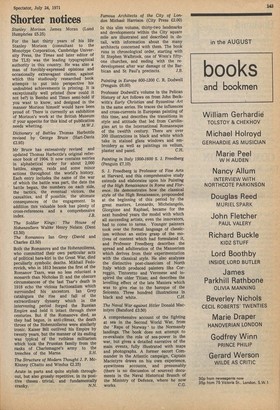Shorter notices
Stanley Morison James Moran (Lund Humphries £5.25) For the last thirty years of his life Stanley Morison (consultant to the Monotype Corporation, Cambridge University Press, the Times and later editor of the TLS) was the leading typographical authority in this country. He was also a man of forcibly-expressed opinions and occasionally extravagant claims, against which this studiously researched book attempts to put into perspective his undoubted achievements in printing. It is exceptionally well printed (how could it not be?) in Bembo and Times semi-bold if you want to know, and designed in the manner Morison himself would have been proud of. There is currently an exhibition of Morison's work at the British Museum if your appetite for this kind of publication needs whetting. M.W.J.
Dictionary of Battles Thomas Harbottle revised by George Bruce (Hart-Davis £2.95) Mr Bruce has extensively revised and updated Thomas Harbottle's original reference book of 1904. It now contains entries in alphabetical order for about 2,000 battles, sieges, raids and some minor actions throughout the world's history. Each entry includes the name of the war of which the battle was part, the date the battle began, the numbers on each side, the tactics, the eventual victors, the casualties, and if possible, the ultimate consequences of the engagement. In addition this valuable book has plenty of cross-references and a comprehensive index. J.B.
The Soldier Kings: The House of Hohenzollern Walter Henry Nelson (Dent £3.50) The Romanovs Ian Grey (David and Charles £3.50) Both the Romanovs and the Hohenzollerns, who committed their own particular acts of political hara-kiri in the Great War, died peculiarly symbolic deaths. Mikhail Fedorovich, who in 1613 became the first of the Romanov Tsars, was no less reluctant a monarch than Nicholas II: and the obscure circumstances of' the last Tsar's death in 1918 echo the vicious factionalism which surrounded his ancestors. Ian Grey catalogues the rise and fall of the extraordinary dynasty which in the intervening period forged the Russian Empire and held it intact through three centuries. But if the Romanovs died, as they had begun, in anti-climax, the death throes of the Hohenzollerns were similarly ironic. Kaiser Bill outlived his Empire by twenty years, but the manner of its ending was typical of the ruthless militarism which took the Prussian family from the ranks of Charlemagne's army to the trenches of the Marne. S.H.
The Structure of Modern Thought J. P. McKinney (Chatto and Windus £2.25) Acute in parts and quite stylish throughout, but also grossly repetitive, in its positive theses. trivial, and fundamentally cranky. N.N. Famous Architects of the City of London Michael Harrison (City Press £2.00) In this slim volume, thirty-two landmarks and developments within the City square mile are illustrated and described in detail, with information about the many architects concerned with them. The book runs in chronological order, starting with St Stephen Walbrook, one of Wren's fiftyone churches, and ending with the redevelopment after war damage of the Bar bican and St Paul's precincts. J.B.
Painting in Europe 800-1200 C. R. Dodwell (Penguin £6.00) Professor Dodwell's volume in the Pelican History of Art follows on from John Beckwith's Early Christian and Byzantine Art in the same series. He traces the influences and cross-currents in European painting of this time, and describes the transitions in style and attitude that led from Carolingian art to the International Romanesque of the twelfth century. There are over 200 illustrations in black and white which take in stained glass windows and embroidery as well as paintings on vellum, plaster and panel. C.H.
Painting in Italy 1500-1600 S. J. Freedberg (Penguin £7.10) S. J. Freedberg is Professor of Fine Arts at Harvard, and this comprehensive study extends and elaborates upon his Painting of the High Renaissance in Rome and Florence. He demonstrates how the classical style of the High Renaissance, propounded at the beginning of this period by the great masters, Leonardo, Michelangelo, Giorgione and Raphael, became for the next hundred years the model with which all succeeding artists, even the innovators, had to come to terms. Younger painters took over the formal language of classicism without an entire grasp of the motives of content which had formulated it, and Professor Freedberg describes the spread and adulteration of the Mannerism which derives from their experimentation with the classical style. He also analyses the distinctive post-classicism of North Italy which produced painters like Correggio, Tintoretto and Veronese and inspired the older Titian; and describes the levelling effect of the late Maniera which was to give rise to the baroque of the Seicento. Three hundred illustrations in black and white. C.H.
The Naval War against Hitler Donald Macintyre (Batsford £3.50) A comprehensive account of the fighting at sea in the Second World War, from the 'Rape of Norway' to the Normandy landings. The book does not attempt to re-evaluate the role of sea-power in the war, but gives a detailed narrative of the main events, fully illustrated with maps and photographs. A former escort Commander in the Atlantic campaign, Captain Macintyre draws on his own experience, eyewitness accounts, and presumably (there is no discussion of sources) documents in the Naval Historical Branch of the Ministry of Defence, where he now works. C.G.










































 Previous page
Previous page